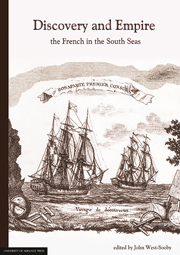Book contents
- Frontmatter
- Contents
- List of Figures
- List of Contributors
- Acknowledgements
- Introduction
- Note on the Second Frank Horner Lecture
- 1 The Globe Encompassed: France and Pacific Convergences in the Age of the Enlightenment
- 2 The Abbé Paulmier's Mémoires and Early French Voyages in Search of Terra Australis
- 3 The Acquisitive Eye? French Observations in the Pacific from Bougainville to Baudin
- 4 Discovering the Savage Senses: French and British Explorers' Encounters with Aboriginal People
- 5 A Case of Peripheral Vision: Early Spanish and French Perceptions of the British Colony at Port Jackson
- 6 New Creatures Made Known: Some Animal Histories of the Baudin Expedition
- 7 “Primitive race”, “pure race”, “brown race”, “every race”: Louis Freycinet's Understanding of Human Difference in Oceania
- 8 Imperial Eyes on the Pacific Prize: French Visions of a Perfect Penal Colony in the South Seas
Introduction
Published online by Cambridge University Press: 05 April 2014
- Frontmatter
- Contents
- List of Figures
- List of Contributors
- Acknowledgements
- Introduction
- Note on the Second Frank Horner Lecture
- 1 The Globe Encompassed: France and Pacific Convergences in the Age of the Enlightenment
- 2 The Abbé Paulmier's Mémoires and Early French Voyages in Search of Terra Australis
- 3 The Acquisitive Eye? French Observations in the Pacific from Bougainville to Baudin
- 4 Discovering the Savage Senses: French and British Explorers' Encounters with Aboriginal People
- 5 A Case of Peripheral Vision: Early Spanish and French Perceptions of the British Colony at Port Jackson
- 6 New Creatures Made Known: Some Animal Histories of the Baudin Expedition
- 7 “Primitive race”, “pure race”, “brown race”, “every race”: Louis Freycinet's Understanding of Human Difference in Oceania
- 8 Imperial Eyes on the Pacific Prize: French Visions of a Perfect Penal Colony in the South Seas
Summary
The French connection with the South Seas stretches back at least as far as the voyage of Binot Paulmier de Gonneville (1503–1505), who believed he had discovered the fabled great south land after being blown off course during a storm near the Cape of Good Hope. The story of his voyage remained largely forgotten for over 150 years, but eventually resurfaced in 1664 thanks to the publication by the Abbé Jean Paulmier of a document in which he argued, on the basis of this supposed discovery, for the establishment of a Christian mission in this “third part” of the world. While historians today contest the authenticity of various aspects of the Abbé Paulmier's Mémoires, there is no doubt about the impact it had in France, both on the collective imagination and, more concretely, on French plans for exploration and colonial expansion. It was not until the eighteenth century, however, that France began sending mariners to the southern oceans on a regular basis, and by that time a new maritime power had begun to emerge: Great Britain. Together, these two nations would play a decisive role in determining the configuration of these little known parts of the globe, and particularly of the Pacific, which had for so long been the almost exclusive preserve of Spain.
The early history of European exploration and discovery in the Pacific Ocean had indeed been dominated by the activities of the Spanish.
- Type
- Chapter
- Information
- Discovery and EmpireThe French in the South Seas, pp. 1 - 14Publisher: The University of Adelaide PressPrint publication year: 2013



